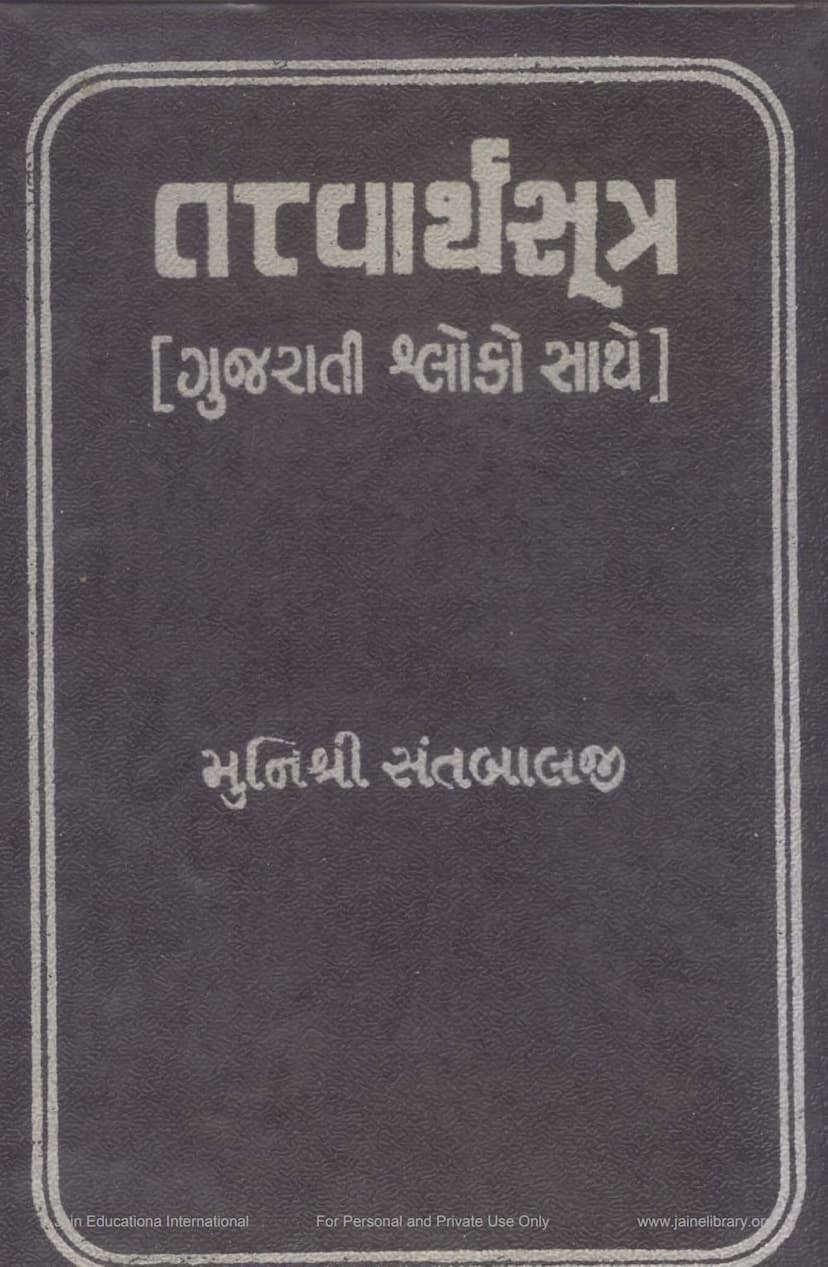Tattvartha Sutra
Added to library: September 2, 2025

Summary
This document is a Gujarati translation and poetic rendition of the Jain Tattvartha Sutra by Muni Shri Santbalji, published by Mahavir Sahitya Prakashan Mandir, Ahmedabad. The work aims to make the profound Jain philosophy accessible, particularly to those who might find the original Sanskrit sutras challenging.
Here's a breakdown of the content based on the provided pages:
Overall Purpose and Context:
- Author: Muni Shri Santbalji
- Work: Tattvartha Sutra, translated into Gujarati verse.
- Publisher: Mahavir Sahitya Prakashan Mandir, Ahmedabad.
- Goal: To simplify and present the Tattvartha Sutra in a poetic, easily memorable format (padyamayam). This is intended for sadhus, sadhvis, and lay followers (shravaks) who wish to internalize its teachings.
- Inspiration: The initiative was partly inspired by the request of Prabhabahen Ajmera and supported financially by various individuals and groups, notably Shri Pushpabahen.
Key Themes and Structure (as reflected in the summaries of chapters):
The Tattvartha Sutra is presented chapter by chapter, with each chapter (Adhyay) being summarized in a poetic, Gujarati verse format. The summaries highlight the core concepts of each chapter:
- Chapter 1: Nayapradhan Darshan - Gyan Vivaran (Emphasis on Nayavada and Knowledge): Focuses on the nature of right perception (samyak darshan), right knowledge (samyak gyan), and right conduct (samyak charitra) as the path to liberation (moksha). It defines various types of knowledge (mati, shruta, avadhi, manah-paryay, keval) and the principles of nayas (perspectives) and pramāṇa (valid cognition).
- Chapter 2: Jiva Lakshana ane Jiva Prakara (Characteristics and Types of Souls): Explains the five soul-types (audayika, kshayika, mishra, audayika, parinami) and their various classifications based on senses, mind, birth, and body. It emphasizes the rarity of human birth and the importance of utilizing it for spiritual progress.
- Chapter 3: Naraki Varnan (Description of Hellish Beings): Details the seven hellish realms (naraka), their characteristics, the lifespans of the beings residing there, and the suffering they endure due to their karma. It also touches upon the geography of the Jain universe, including continents, mountains, and human realms.
- Chapter 4: Dev Varnan (Description of Heavenly Beings): Describes the different classes of celestial beings (devas), their realms (Vaimanika, Jyotishka, Vyantaras, Bhavanapatis), their lifespans, the nature of their bliss, and their interactions with humans and the Tirthankaras. It highlights the concept of karma influencing one's rebirth in different realms.
- Chapter 5: Ajiva Vistar (Elaboration on Non-Soul Substances): Explains the five eternal substances (dravyas) in Jainism: Jiva (soul), Ajiva (non-soul) which comprises Dharma, Adharma, Akasha, Pudgala, and Kala (time). It delves into the nature of Pudgala (matter) and its various forms and attributes, as well as the supportive functions of Dharma (motion) and Adharma (rest) and the pervasive nature of Akasha (space).
- Chapter 6: Papa Punya ane Dharma-Adharma Vibhaga (Sin, Merit, and the Division of Dharma/Adharma): Discusses the causes of karma binding – the eight primary karmas and their subdivisions, detailing what leads to the accumulation of merit (punya) and sin (papa). It explains how actions, thoughts, and speech, influenced by passions (kashayas) and vices, lead to the influx of karma.
- Chapter 7: Sadhana (Spiritual Practice): Focuses on the path of spiritual practice, emphasizing the importance of vows (vrata), observances, and ethical conduct. It elaborates on the five great vows (ahimsa, satya, asteya, brahmacharya, aparigraha) and their minor transgressions (atichara), and the practices of samiti (carefulness) and gupti (restraint). It also details the twenty-two types of hardships (parishaha) that ascetics should endure with equanimity.
- Chapter 8: Karma Bandha Vishleshan (Analysis of Karma Binding): Provides a detailed analysis of the binding of karmas, explaining the eight main types of karma and their numerous sub-categories. It elaborates on the causes and processes of karma influx (asrava) and binding (bandha), and the factors influencing the duration and intensity of karma (prakriti, sthiti, anubhav, pradesha).
- Chapter 9: Samvara - Sudhyana - Nirjara - Anukrama (Stopping Influx of Karma, Meditation, Elimination of Karma, and Sequence): Explains the path to stop new karma influx (samvara) through self-restraint, meditation (dhyana), and austerities (tapa). It details the practice of different types of meditation (art, raudra, dharma, shukla) and the different stages of spiritual progress (gunasthanas).
- Chapter 10: Moksha Parinishthiti (The State of Liberation): Describes the ultimate goal of Jainism – liberation (moksha). It explains that liberation is achieved through the complete annihilation of all karmas, leading to the soul's pure, omniscient, and blissful state. It outlines the process of liberation and the characteristics of the liberated soul residing in the Siddhashila.
Key Insights and Features:
- Poetic Rendition: The Tattvartha Sutra, a foundational text of Jainism, is presented in beautiful Gujarati verses, making it more accessible and enjoyable for readers.
- Comprehensive Explanation: Each Adhyay is accompanied by a summary, explaining the core concepts and their interrelations within the Jain philosophical framework.
- Scholarly Depth: The text draws upon original Sanskrit sutras and various commentaries, indicating a deep understanding of the subject matter.
- Contextualization: The summaries connect Jain teachings to broader Indian philosophical traditions (like the Gita) and even modern scientific and philosophical ideas, showing the relevance and depth of Jain thought.
- Emphasis on Practice: The Tattvartha Sutra is not just theoretical; the book highlights the practical aspects of spiritual discipline, vows, austerities, and meditation necessary for achieving liberation.
- Author's Intent: Muni Santbalji's work is a testament to his devotion and his commitment to making Jain wisdom widely available. The introduction by Bechardas Doshi and Dalshukh Malvania further contextualize the work and praise the author's efforts.
In essence, this Gujarati Tattvartha Sutra by Muni Santbalji is a valuable resource for anyone seeking to understand the fundamental principles of Jainism in a clear, poetic, and spiritually enriching manner.